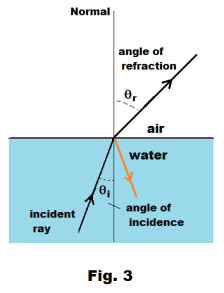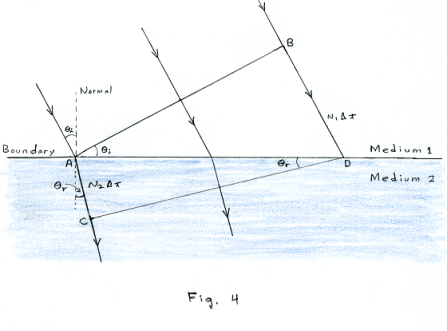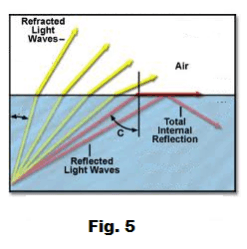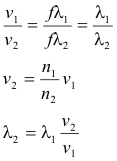
Website owner: James Miller
Light. Laws of reflection and refraction. Angle of incidence, reflection, refraction. Optical density. Index of refraction. Critical angle and total internal reflection. Phase changes on reflection.

Reflection of light. Reflection is the turning back of light waves from a surface. Light is reflected from a surface in a way similar to the way an elastic ball rebounds from a wall or a sound wave is reflected from a cliff.
The amount of light an object reflects depends on:

1) The kind of material it is made of
2) The smoothness of the surface (how polished it is)
3) The angle at which the light strikes its surface
Polished aluminum is a better reflector than polished black plastic. Polished metal is a much better reflector than rough metal. The glare of the setting sun on the surface of a lake shows that light is strongly reflected when light rays strike a surface at an oblique angle.
Def. Normal. A line drawn perpendicular to a plane.
Def. Angle of incidence. The angle between the incident ray and the normal drawn to the point of incidence. See. Fig. 1.
Def. Angle of reflection. The angle between the reflected ray and the normal drawn to the point of incidence. See Fig. 1.
Substance |
Index of Refraction |
Air |
1.0003 |
Ice |
1.31 |
Water |
1.33 |
Gasoline |
1.38 |
Ordinary glass |
1.5 |
Plexiglas |
1.51 |
Dense optical glass |
1.6-1.9 |
Zircon |
1.92 |
Diamond |
2.42 |
Table 1
Def. Plane of incidence. That plane containing the incident ray and the normal at the point of incidence.
Experiment gives the following laws of reflection for light.
Laws of Reflection:
1. The angle of reflection is equal to the angle of incidence.
2. The reflected ray lies in the plane of incidence (it lies in the plane containing the incident ray and the normal at the point of incidence.)
These laws of reflection are also valid for the reflection of other types of waves, including sound waves.
Refraction of light.

Optical density. A measure of the speed at which light is transmitted through a transparent substance. The higher the optical density of the medium, the slower light travels in the medium.
Def. Index of refraction. The ratio of the speed of light in a vacuum to its speed in a given substance.
The index of refraction of a substance is a measure of its optical density. Table 1 contains the index of refraction of various substances.
In general, when a beam of light, traveling in a transparent medium, strikes the surface of a second transparent medium of a different optical density, the beam will split. Part of it will be reflected back into the original medium and the other part will pass on into the new medium as a refracted beam. Refraction is the bending of light rays as they pass from one medium into another medium of different optical density.

Def. Angle of refraction. The angle between the refracted ray and the normal drawn to the point of refraction. See Fig. 2.
Laws of refraction.
Law 1. When a ray of light passes obliquely from a medium of lesser to one of greater optical density, it is bent toward the normal. Conversely, a ray of light passing obliquely from a denser to a less dense medium is bent away from the normal. See Figures 2 and 3.
Law 2. The refracted ray lies in the same plane as the incident ray and the normal.
Law 3. The angle of incidence θi and the angle of refraction θr are related as follows:

where
v1 = velocity of light in Medium 1
v2 = velocity of light in Medium 2
n1 = index of refraction of Medium 1

n2 = index of refraction of Medium 2
The constant
![]()
is called the coefficient of refraction of Medium 2 with respect to Medium 1. When Medium 1 is a vacuum, it is simply called the (absolute) index of refraction of Medium 2.
The index of refraction for air is essentially the same as that for a vacuum since the speed of light in air is essentially the same as in a vacuum.
Law 3 is known as Snell’s Law. We see from 1) that the connection between θi and θr is given by the simple relationship
2) n1 sin θi = n2 sin θr
Fig. 2 shows a ray passing from a less dense medium (air) into a more dense medium (water). Fig. 3 shows a ray of light passing from a denser medium (water) into a less dense medium (air). As can be seen, in the later case the ray is bent away from the normal.
When a ray of light passes from a medium of one optical density to one of a different density, why does it abruptly change direction? Insight can be seen in the following: Suppose you are driving down a highway and your right front wheel accidently goes off the hard pavement onto a soft shoulder. The right front wheel will be slowed down by the soft shoulder and the vehicle will be pulled to the right. It will cause the vehicle to veer to the right.
Derivation of formula sin θi /sin θr = v1 /v2 . Consider Fig. 4 in which a plane wave is incident on the boundary between two media at an angle of incidence of θi. Assume the velocity of light in Medium 1 is v1 and the velocity in Medium 2 is v2. Suppose that at time t = t0 the wave front is at position AB where it is just making contact with the boundary at point A. Suppose that at time t = t0 + Δt wave front AB has advanced to the position CD where we use Huygens’ Principle for finding the new position of the wave front. Now AC is perpendicular to CD and AB is perpendicular to BD. In addition,

BD = v1Δt
AC = v2Δt
![]()
![]()
Hence

-----------------------------------

The critical angle and total internal reflection. In Fig. 3 is shown a ray of light passing from a medium of higher optical density into a medium of lower optical density (in this case from water into air). If we increase the angle of incidence θi, the angle of refraction θr will also increase. If we keep increasing the angle of incidence θi, we reach a point where the angle of refraction θr becomes 90o. The value of the angle of incidence θi, at which the angle of refraction becomes 90o is called the critical angle. What happens when we increase θi beyond the critical angle? We then have total internal reflection. Fig. 5 shows this situation. What actually happens is that when the angle of incidence θi is less than the critical angle, there is both a refracted beam and a reflected beam. As the angle of incidence increases, the strength of the reflected beam becomes stronger at the expense of the refracted beam. When the angle of incidence passes the critical angle, the refracted beam and the reflected beam become one, giving total reflection.
The critical angle for any two given substances can be found by setting θr = 90o or sin θr =1 in Snell’s Law. Thus
sin θc = n2/n1
Example. Compute the critical angle of an air-glass surface, taking 1.50 as a typical index of refraction of glass.
sin θc = 1/1.50 = 0.67
Thus θr = 42o.
Applications of total internal reflection. Applications of total internal reflection include:
1. Reflecting prisms as used in binoculars, reflecting telescopes, submarine periscopes, etc.
2. Cutting of gems, such as diamonds.
3. Rods of clear, colorless plastic that can be bent into unusual shapes, used for transmitting light. Beams of light entering one end of the rod are totally reflected by the walls and emerge at the other end.
Phase changes on reflection. For normal and nearly normal angles of incidence, light traveling in a rarer medium will undergo a 180o phase change when reflecting from a denser medium. There is no phase change at other angles and no phase change when light traveling in a denser medium reflects at a rarer medium. When light passes from one medium to another, there is no phase change.
Change in wavelength when light passes from one medium into another. When light passes from one medium to another, not only does its speed change, but its wavelength also changes. Its frequency remains the same. The wavelength, frequency and speed are related by the formula v = fλ. If v1, λ1, n1 are the speed, wavelength, and index of refraction in Medium 1 and v2, λ2, n2 are the speed, wavelength, and index of refraction in Medium 2, then

References
Dull, Metcalfe, Brooks. Modern Physics
Sears, Zemansky. University Physics
Freeman. Physics Made Simple
Jesus Christ and His Teachings
Way of enlightenment, wisdom, and understanding
America, a corrupt, depraved, shameless country
On integrity and the lack of it
The test of a person's Christianity is what he is
Ninety five percent of the problems that most people have come from personal foolishness
Liberalism, socialism and the modern welfare state
The desire to harm, a motivation for conduct
On Self-sufficient Country Living, Homesteading
Topically Arranged Proverbs, Precepts, Quotations. Common Sayings. Poor Richard's Almanac.
Theory on the Formation of Character
People are like radio tuners --- they pick out and listen to one wavelength and ignore the rest
Cause of Character Traits --- According to Aristotle
We are what we eat --- living under the discipline of a diet
Avoiding problems and trouble in life
Role of habit in formation of character
Personal attributes of the true Christian
What determines a person's character?
Love of God and love of virtue are closely united
Intellectual disparities among people and the power in good habits
Tools of Satan. Tactics and Tricks used by the Devil.
The Natural Way -- The Unnatural Way
Wisdom, Reason and Virtue are closely related
Knowledge is one thing, wisdom is another
My views on Christianity in America
The most important thing in life is understanding
We are all examples --- for good or for bad
Television --- spiritual poison
The Prime Mover that decides "What We Are"
Where do our outlooks, attitudes and values come from?
Sin is serious business. The punishment for it is real. Hell is real.
Self-imposed discipline and regimentation
Achieving happiness in life --- a matter of the right strategies
Self-control, self-restraint, self-discipline basic to so much in life